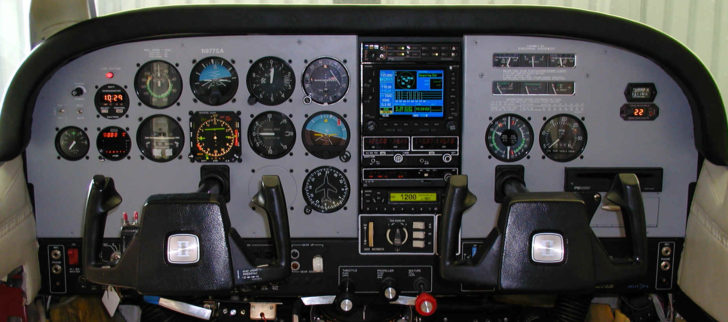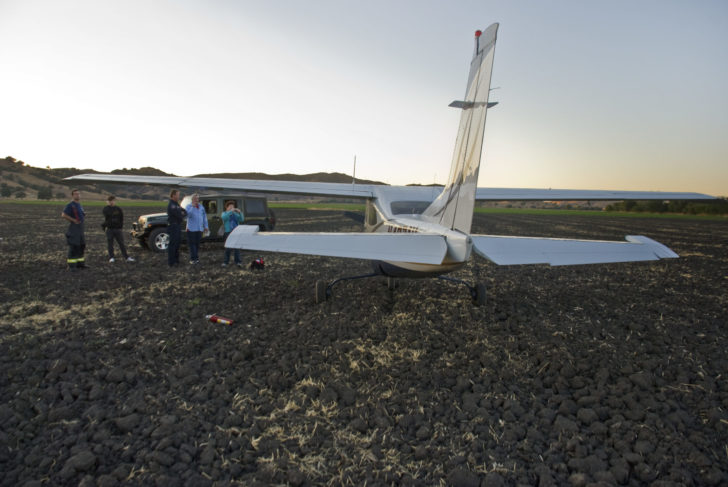Scottrick is busy today, trying to get a real job. As his Dad, I’m watching with interest this new part of his life after twenty-three years of school. He asked me to fill in and, in my defense, he suggested the topic.
I wrote before that I hold a genuine FAA issued Airmen Certificate and fly little planes, with a propeller out front, for personal trips. This story is meant to reassure you, but it’s about an engine failure in flight. The first thing to note is that I’m writing about it. No one was hurt. No property was damaged. The plane, except for the engine, was not damaged in any way. We use that plane for most of our trips today.
As frequent flyers you’ve reconciled yourselves to the magic of being held up in the sky by an invisible force, with roaring engines reassuring you that some very smart person designed this thing to do this trick. Few people have experienced the quiet when the engines stop, but planes are designed and pilots are trained to deal with that possibility. Planes are pretty good gliders; They do not drop out of the sky when the engines stop. The higher you are, the safer you are, because the pilot has more time to deal with the situation. Here’s my story:
October 12, 2008, Marsha and I were flying home (to Palo Alto airport) after a long weekend in Phoenix. We had stopped for lunch with Marsha’s father in Palm Springs. It was about 3 PM on that Sunday afternoon and I had been slowly descending toward the airport which was 25 miles away. We were only 4000 feet above the ground because I was nearing the airport. One thing about small planes is that the ‘passenger’ sits beside the pilot and has a bunch of dials in front of her and little to do but stare at them. Every time a needle flickers, Marsha points it out. (Needles are supposed to flicker. Otherwise they’d just paint stripes on the dials.)

This time the needles did more than flicker. Some went right, some went left, and Marsha got my attention. I noticed the RPM gauge said zero, but I could see out the window that the propeller was still turning. Then everything got quiet.
Pilots are trained for engine failures. The first step is establishing the ‘best glide’ speed, printed on the emergency checklist and memorized by pilots. The best glide speed allows me to travel the furthest with the least loss of altitude. My rule of thumb is that I have about a minute and a mile per thousand feet, so at 4000 feet I had about four minutes to find a place to land within about four miles. So I slowed the plane to about 85 knots, plenty of speed to keep us in the air and under control, but slow enough to give me time to come up with the next step.
The usual next step is to restart the engine. Most planes have two fuel tanks, two spark plugs in each cylinder, and separate electrical systems to fire the spark plugs. So you try each one separately to find a winning combination. That can be done in about fifteen seconds. Four minutes (from 4000 feet) is really a long time, so there’s no reason to panic.
But I didn’t try any of those things, mostly because I instinctively knew the engine was toast. After bouncing around a bit, the RPM, the oil pressure, the fuel flow gauges all said zero. But the propeller was spinning! I didn’t think it all the way through instantly, but the crankshaft had broken. The front half, connected to the propeller, was spinning. The back half, connected to a lot of those gauges and things like the fuel pump and the oil pump, had stopped. This engine would never run again.
So my next step was looking down. There were no airports within gliding distance. I’ve joked about finding something ‘soft and cheap’ to hit, but fortunately we were near an area with small farms. Another chance to relax, not that I had had time to become stressed. I was busy doing my job.
While we both looked for a good farm to visit, I made a radio call. I’m always in contact with controllers, even though it isn’t legally required. “Mayday, mayday, mayday, seven four uniform (N4674U) has an engine failure. I’m looking for a place to land.” The controller couldn’t help much, but he knew where I was and would keep other planes away from me. Fortunately there was another small plane near me and he circled above me until I landed and reported where that was.
There is a reminder for pilots: Aviate, Navigate, Communicate. It’s a reminder to fly the plane first, point in the right direction second, and deal with the radio last. I had set up the best glide speed, given up on the engine (Aviating); then started looking for a landing field (Navigating); and then talked to the controller (Communicating).
While the green fields with crops growing looked soft and tempting, I chose a brown field that had recently been harvested. I liked it because I could see there were no irrigation ditches or pipes or other surprises hidden beneath the crops. It was long enough without nearby electrical wires or other obstructions. And, there was a road reasonably close. I circled over it and set up for landing like I usually do. As I got close, I told Marsha to open her door a crack. (If the plane crumples, the doors can jam. An open door in a crumpled plane is an asset.) The field was bumpy, with big chunks of clay soil. I landed as gently as possible and kept the nose of the plane up until we slowed and the nose wheel dropped into the dirt. Small planes often flip forward (slowly) in soft fields. No one gets hurt, but it’s very embarrassing to be hanging upside down by your seat belt.
Marsha says this was one of my better landings, even compared to landing on a concrete runway. We got out of the plane and wondered how we would get home. That was our biggest problem!

A couple of boys from a neighboring farm drove up in their jeep. I used my cell phone to call the Palo Alto tower and report our predicament. The tower controller called others in the FAA system. A fire truck showed up but found nothing to do. A sherriff showed up and didn’t know what to do. Another sherriff car showed up and then a third. They all thought this was fascinating. One sherriff car got stuck in the mud driving away. Eventually the boys drove us home in their jeep.
This is called an ‘off field landing’, even though it was in a field. (The term must refer to an airfield.) It was not a crash in any way. The NTSB/FAA doesn’t consider it an incident or an accident. No one was hurt. The airplane was not hurt. No property was damaged.
Over the next couple of days we arranged for a mechanic to come out with some tools. He removed the wings and the tail. The whole thing was put on a flat bed truck and taken to his shop. A new engine was ordered. Everything was put back together and the plane flies better than ever.
Airplanes, even small ones, have incredible engineering. When there are accidents, they are studied to make future planes and pilots (and their passengers) safer. This was a textbook experience where everything (including me) worked as it should. [Scott’s edit: You can find an article with fewer details in the Gilroy Dispatch. This family doesn’t make the news that often!]


